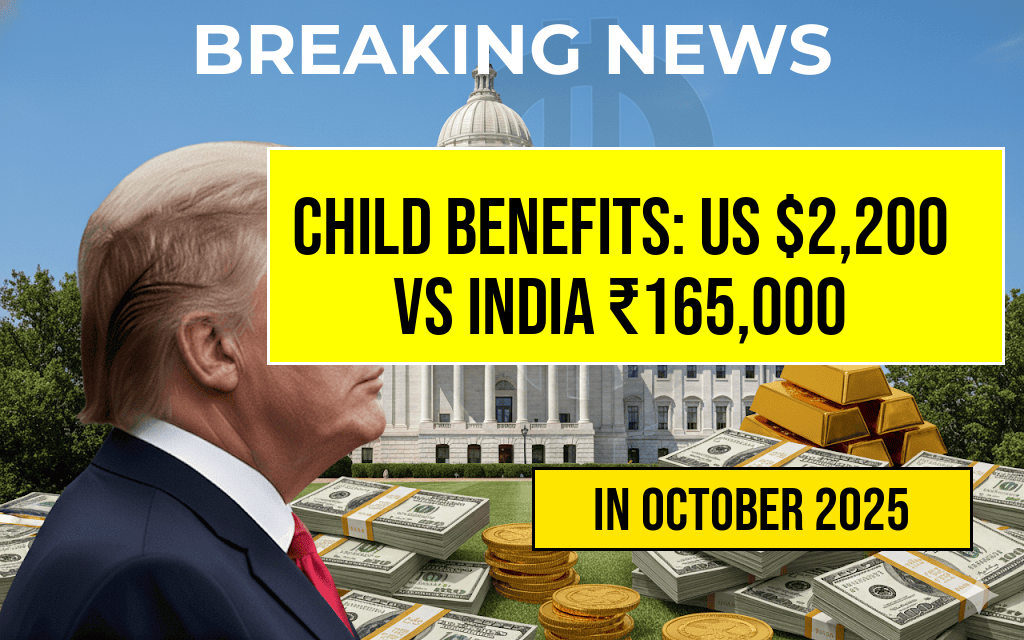Across the globe, governments implement various strategies to support families and promote child welfare through financial assistance. The United States offers a $2,200 Child Tax Credit per child, which has been a cornerstone of its family support policy in recent years. Conversely, India provides a direct monetary benefit of approximately ₹165,000 (roughly $2,000 USD) per child, reflecting a different approach rooted in its economic structure and developmental priorities. While these figures seem comparable in dollar terms, their relative impact, eligibility criteria, and broader social contexts reveal significant differences in how each country prioritizes child welfare. This comparative perspective underscores the complexities of translating support policies across diverse economic landscapes and highlights the importance of understanding local needs and fiscal capacities.
Understanding the US Child Tax Credit
Overview and Eligibility
The Child Tax Credit (CTC) in the United States has undergone several reforms, with the most recent expansions enacted through the American Rescue Plan Act of 2021. Currently, eligible families can claim up to $2,000 per qualifying child under age 17, with a portion of this credit being refundable, meaning families can receive the benefit even if it exceeds their tax liability. To qualify, families must meet income thresholds, typically earning under $75,000 for single filers and $150,000 for married couples filing jointly.
Impact and Criticism
The CTC aims to reduce child poverty and provide economic stability to low- and middle-income families. According to the U.S. Treasury Department, the expanded credit during 2021 and 2022 significantly lowered child poverty rates, especially among Black and Hispanic communities. However, critics argue that the temporary nature of the policy and income caps limit its long-term effectiveness. Discussions persist about making the credit fully refundable and expanding eligibility to further alleviate child hardship.
India’s Child Benefit Scheme
Scope and Implementation
India’s approach to child welfare involves a series of targeted schemes, with the Integrated Child Development Services (ICDS) and the National Child Benefit Scheme among the most prominent. The ₹165,000 benefit cited here reflects direct cash transfers under the National Child Development Program, aimed at supporting children in economically disadvantaged families. These transfers are often linked to school enrollment, health check-ups, and nutritional support, emphasizing a holistic approach to child development rather than cash alone.
Socioeconomic Context and Challenges
India faces distinct challenges, including high levels of poverty and limited social safety nets, which influence the scale and scope of its child benefits. While the monetary amount appears substantial, the actual purchasing power and access to services vary widely across regions. The government continues to expand social welfare policies, but coverage remains inconsistent, often constrained by administrative capacity and funding limitations.
Comparison of Financial Support and Social Impact
| Aspect | United States | India |
|---|---|---|
| Annual benefit per child | $2,200 (Child Tax Credit) | ₹165,000 (~$2,000 USD) |
| Eligibility criteria | Income thresholds, age under 17, tax filing status | Income-based, linked to social welfare programs, school enrollment |
| Type of support | Tax credit, refundable for low-income families | Cash transfer, often conditional on health and education |
| Coverage | Majority of working families with children | Limited to targeted vulnerable populations |
| Impact on child poverty | Significant reduction, especially among marginalized groups | Improves nutritional and educational outcomes in targeted groups |
Broader Social and Economic Considerations
The differences in how the US and India structure their child benefits reflect broader socioeconomic realities. In the US, a relatively high-income country with a well-established social safety net, the focus is on tax-based incentives designed to incentivize work and support families with moderate to high incomes. Meanwhile, India’s cash transfer schemes are often aimed at addressing extreme poverty and ensuring basic needs are met, with conditionalities tied to health and education outcomes.
Furthermore, cultural expectations around family and government intervention shape policy design. In India, community and family networks traditionally play a significant role in child-rearing, but government programs aim to complement these structures, especially in impoverished regions. In contrast, the US emphasizes individual tax relief and targeted social programs, reflecting different governance models and societal priorities.
Conclusion
While the nominal figures of child benefits in the US and India appear similar, their implications diverge considerably when contextualized within each country’s economic environment and social fabric. The US’s $2,200 tax credit functions as a partial safety net for middle-income families, whereas India’s ₹165,000 transfers are often a lifeline for the most vulnerable children in impoverished communities. This comparison underscores the importance of tailoring social support policies to local realities, balancing fiscal capacity with the goal of fostering equitable child development worldwide.
Frequently Asked Questions
What is the child benefit amount in the United States compared to India?
The United States offers a $2,200 child tax credit per child, while India provides approximately ₹165,000 in child benefits, highlighting significant differences in international support levels.
How do the child benefit systems differ between the US and India?
The US primarily offers a tax credit that reduces tax liability, whereas India provides direct cash transfers to families, reflecting different approaches to supporting children’s welfare.
What factors influence the disparity in child benefits between the US and India?
The disparity is influenced by the countries’ economic development, social policies, and budget allocations. The US has a higher per capita income but offers a lower direct cash benefit compared to India’s targeted cash transfer programs.
Are child benefits sufficient in either country to cover the cost of raising a child?
While the US benefit helps offset some expenses, it often isn’t enough to cover the full cost of raising a child. In India, direct cash transfers aim to support basic needs, but overall adequacy varies based on local living costs.
How can families in each country maximize the benefits available to them?
Families should stay informed about eligible programs, tax credits, and cash transfer schemes. Consulting with local social services and financial advisors can help maximize the support based on individual circumstances.






